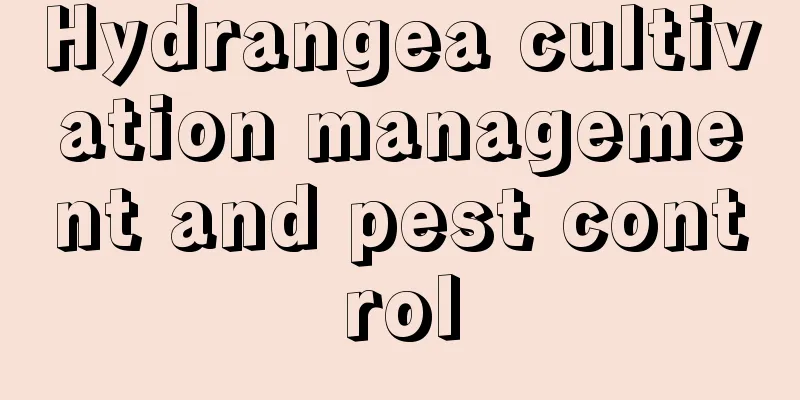Hydrangea cultivation management and pest control

|
Hydrangea is a flower that many people grow. When it blooms, the flower balls are compact and dense, which is very ornamental and is a very popular flower variety. Here is an introduction to hydrangea cultivation management and disease and pest control . 1. Soil Hydrangeas prefer fertile and loose soil that is slightly acidic or slightly alkaline. You need to choose soil with a suitable pH value, fertility, looseness, and good air permeability and water permeability. When planting in the ground, it is necessary to maintain good soil air permeability and water permeability. It is not advisable to choose low-lying areas for planting, otherwise it will easily lead to water accumulation and root rot, which may cause the death of the plant in severe cases. 2. Watering Hydrangeas evaporate a lot of water under the sun, so they need to be replenished with water in time. In summer, they should be watered twice a day to maintain the humidity of the surrounding environment. Pay attention to maintaining ventilation in the planting environment. 3. Fertilization During the growth period of hydrangea , choose water-soluble fertilizers and granular slow-release fertilizers containing phosphorus and potassium; during the bud formation period, use a small amount of nitrogen fertilizer in combination with high-phosphorus and potassium liquid fertilizer, and apply it through root irrigation and leaf spraying to promote the plant to better absorb nutrients; after flowering, water-soluble fertilizers should be applied in time for topdressing to replenish the large amount of nutrients consumed due to flowering. 4. Pruning Hydrangea pruning should be completed from May to August, and after flowering, it needs to be pruned at the height of the buds 3 to 4 nodes below the flower head. If there are tall and thin branches, 1/2 of the crown width needs to be removed to promote the sprouting of strong new branches at the bottom of the plant; when there are a certain number of strong new branches, a second pruning should be carried out before August to remove the original thin branches, diseased branches and severely lignified branches to ensure the flowering quality and replacement of old and new branches in the second year. 5. Pest and disease control Hydrangea has strong disease resistance and fewer diseases and pests. Anthracnose occasionally occurs during the growing period. In the early stage of the disease, use 800 times diluted thiophanate-methyl for treatment, and spray carbendazim, methyl thiophanate and other drugs once every 10 days for prevention. Hydrangeas are very prone to red spider mites. When red spider mites occur, choose the special medicine, 1500 times diluted carbendazim, and spray it once every 3 days for control. Hydrangea powdery mildew can be prevented regularly by using some drugs, such as Green Princess, Cui Bei, etc., spray the whole plant and the surrounding planting area evenly once every 7 to 10 days. That’s it |
<<: How to water camellia when it blooms? Can I spray water during the flowering period?
>>: How to grow camellia indoors? Is it good to grow it at home?
Recommend
Is Strelitzia poisonous?
1. Toxicity of Strelitzia Many curious friends ha...
Bean planting technology and management technology
In southern China, the area of bean cultivation...
Is it profitable to grow Chinese medicinal materials? Is it profitable to grow Chinese medicinal materials?
Is it profitable to grow Chinese medicinal herbs?...
Can honeysuckle be repotted in spring?
1. Can I repot in spring? You can repot the honey...
How often should I water Cineraria?
1. How often should I water? Anyone who has raise...
Seed propagation of black-eyed Susan
How to Propagate Black-Eyed Susan There are two w...
How to grow irises hydroponically? What to do if the roots rot during hydroponics?
1. Hydroponic method 1. Select the plant: In addi...
How many kilograms of grain are generally produced per mu? Analysis of grain crop yield per mu and profit
Grain yield per mu The main food crops in my coun...
How to make roses survive easily through cuttings
1. Cutting time Rose cuttings are suitable for sp...
Schefflera chinensis soil changing time and method
Time to change the soil of Schefflera The Scheffl...
When is the best time to plant chives?
Which month is suitable for planting chives? Chiv...
What plants are suitable for sowing in June?
Flowers suitable for sowing in June In June, most...
How often should azalea be watered?
How often should azalea be watered? In spring, it...
How to make Clematis bloom more
1. Flowering period Its flowering period is relat...
How many days does it take for coriander to germinate? How to plant coriander so that it germinates quickly and well?
How long does it take for coriander to germinate?...









